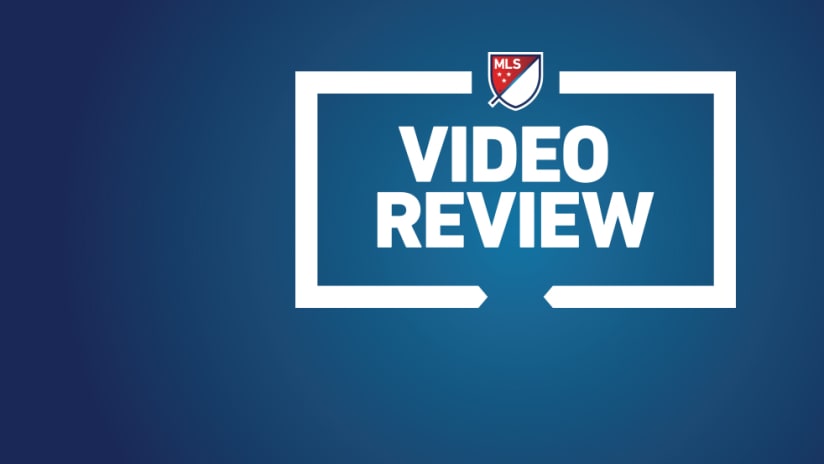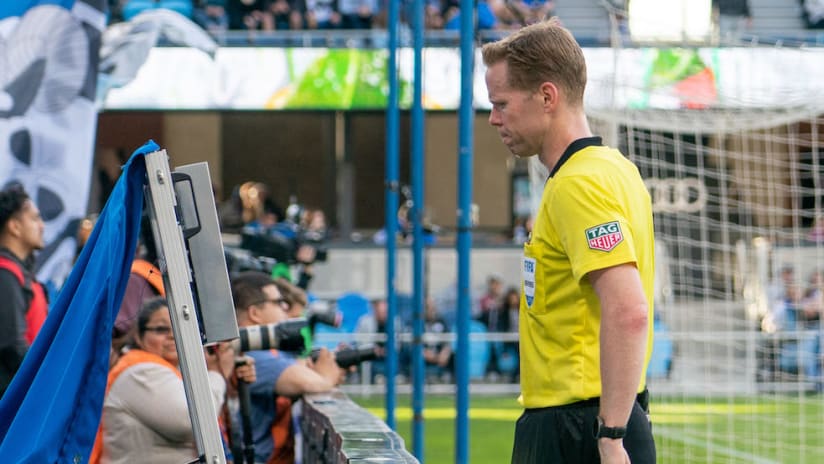Who created the Video Review process in soccer?
Over the last three years, MLS has collaborated with The International Football Association Board (IFAB), the world body that oversees the rules of the sport, to establish the protocol for Video Review in soccer. The IFAB is expected to decide whether to formally incorporate Video Review as part of the Laws of the Game in 2018 or 2019.
Is this the first time replays have been used in professional soccer to help referees make decisions on the field?
MLS was the first league in the world to implement Video Review in a live competitive match in the USL in 2016 (New York Red Bulls II vs. Orlando City B). When MLS launches Video Review on Saturday, August 5, 2017 it will be the third top-flight league in the world to make video technology available to referees during live competition. Australia’s A-League and South Korea's K-League implemented Video Review a short time before MLS. Other prominent leagues, including Germany’s Bundesliga and Italy’s Serie A, are launching Video Review in the 2017/18 season.
How does Video Review work?
The Video Assistant Referee (VAR), the new fifth member of the officiating crew, will be positioned in a booth with all available replays from the match broadcast. The VAR’s job is to check for a potential clear error or a serious missed incident in four (4) match-changing situations: (1) goals, (2) penalty kicks, (3) straight red cards and (4) cases of mistaken identity. These are the only reviewable plays in a match.
Upon a recommendation to the referee by the VAR for a Video Review of a potential clear error, it's the head referee's decision whether to perform a Video Review by making the Video Review signal (TV box motion) at the first natural stoppage or when the ball is in a neutral zone. A neutral zone is an area of the field where neither team has an attacking advantage.
Who are the Video Assistant Referees? Are they trained referees?
Video Assistant Referees are certified referees, overseen and assigned by the Professional Referee Organization (PRO). They undergo specific training by PRO on the Video Review protocol as established by the IFAB.
Does the clock stop during a Video Review?
The match clock does not stop during Video Review. Any time used for Video Review will be added in stoppage time at the referee’s discretion.
Will Video Review slow the game down or interrupt play?
Video Review can only be employed in four (4) match-changing situations (goals, penalty kicks, straight red cards and mistaken identity), helping to ensure that it achieves maximum benefit with minimum interference to the match.
Is there a time limit to Video Reviews?
Referees are under no time constraints to complete a review. Any time used for Video Review will be added in stoppage time at the referee’s discretion.
How will fans know that a Video Review is happening if they're at the stadium or watching on TV?
The head referee will indicate a Video Review by making the Video Review signal (TV box motion). The in-stadium video board and public address announcements will display and communicate Video Reviews as well as the referee’s final decision.
The same information will also be communicated to the match broadcasters, who will relay it to the television viewers. The replay used to make the final determination will be shown on the stadium video board and made available to all TV broadcasters.
Does the Video Assistant Referee (VAR) have access to special in-stadium camera angles during a match?
The VAR and head referee only have access to the camera angles and replays available from the match TV broadcast(s).
Who makes the decision during a Video Review: the Video Assistant Referee (VAR) or the head referee?
The final decision on any play during a match, including whether to conduct a Video Review, rests with the head referee. The VAR may recommend a Video Review to the head referee if there is a potential clear and obvious error on one of four (4) match-changing situations: (1) goals, (2) penalty kicks, (3) straight red cards and (4) cases of mistaken identity. These are the only reviewable plays in a match.
If the referee doesn’t call for a Video Review during one of the four (4) match-changing situations, does that mean the referees have opted not to check the replays of these incidents?
Every single play that falls under one of the four (4) match-changing incidents is being checked and analyzed by the Video Assistant Referee (VAR) in the booth. If there is no video evidence of a clear and obvious error, or the video evidence is inconclusive, and a Video Review is not recommended or deemed necessary, the match continues uninterrupted.
Will the head referee watch the replays from the sideline in every instance of Video Review?
During a Video Review, a head referee may opt to watch the replays via a monitor available on the sideline in a designated area (the Referee Review Area) OR the referee may opt to use the information from the Video Assistant Referee (VAR) before deciding whether to uphold or overturn the on-field decision.
The final decision, as always, rests with the head referee.
What is a "check" and how does that differ from a "Video Review"?
All reviewable incidents throughout a match are constantly checked and analyzed by the VAR for potential clear and obvious errors. The head referee may decide to hold a restart to allow for a check and the universal signal for this is the hand to the earpiece.
When a clear and obvious error is identified as part of a check, the VAR alerts the head referee, who can then decide whether to initiate a Video Review by making the Video Review signal (TV box sign).
Does the referee have to conduct a Video Review immediately following a clear and obvious error on one of the four (4) match-changing incidents? How much time can pass before an incident is no longer reviewable?
The head referee can go back to review any incident that happens between stoppages in play. However, if play is restarted after a stoppage (ex. on a throw-in, corner kick, goal kick, free kick or drop ball) then a referee CANNOT go back to review any instances prior to that restart (except for a serious missed incident involving violent conduct, spitting or extremely offensive/insulting/abusive gestures). For that reason, the head referee may delay a restart until a VAR check of a reviewable play is complete.
What happens if play doesn’t stop or the referee can’t stop play because the ball is never in a neutral zone? When can Video Review take place in that case?
The head referee can go back to conduct a Video Review at the first stoppage in play (whether it’s a natural stoppage in play or the referee stops play in a neutral zone). At that point the head referee can review any potential clear and obvious errors in any of the four (4) match-changing situations that may have occurred during the time between stoppages.
However, once a match restarts after a stoppage in play, then a referee CANNOT go back to review any incidents that occurred prior to the restart (the lone exception being a serious missed incident involving violent conduct, spitting or extremely offensive/insulting/abusive gestures).
What if an on-field decision is overturned, but there were other actions that took place after the reviewable play in question? What happens to those plays?
If a decision is overturned after Video Review, then play resumes from that point in the match and any actions that happened after the point of the overturned decision are erased.
Only disciplinary cards issued by the referee are never erased except for cards shown in cases of DOGSO or the stopping of a promising attack: If an attack is erased following an overturned decision, any cards for stopping the attack are also wiped away.
What are some referee decisions during a match that are not reviewable by the officials?
The following are examples of referee decisions that are NOT reviewable:
- Throw-in decisions (including placement and execution);
- Goal kick decisions (including placement and execution);
- Corner kick decisions (including placement and execution);
- Foul decisions (including placement and execution of free kick);
- Offside decisions (unless an offside decision impacts goals, penalty kicks and red cards);
- Yellow card decisions, including second yellow cards (unless awarding the yellow was a clear and obvious error; Ex. the yellow card should have been a red card OR there was a case of mistaken identity);
- Distance of opposing players from free kicks or corner kicks.
Can a yellow card be awarded as a result of a Video Review?
While yellow card decisions are NOT reviewable, the head referee can decide to caution any players following a Video Review for goals, penalty kicks, red cards or mistaken identity.
Note: A foul that originally received a yellow card could be reviewed if a potential red card was warranted OR in case the yellow card was awarded to the wrong player (mistaken identity).
What is the Attacking Phase of Play (APP) and how does it impact Video Review?
The Attacking Phase of Play (also known as APP) as determined by the referee begins when a team starts the attacking move toward the opposition's penalty area, leading up to a match-changing incident. The Attacking Phase of Play should not be confused with “keep-ball,” when the attacking team maintains a long duration of possession without purposeful movements toward goal.
Infractions that occur during the Attacking Phase of Play may negate reviewable, match-changing incidents during a match: goals, penalty kicks and red cards for DOGSO.
Can club coaches, staff or players request a Video Review similar to other professional sports?
Because every key match-changing incident is being checked, there is no need for players and staff to request a review. The head referee and ONLY the head referee can initiate a Video Review. Players or team staff cannot influence the referee during a Video Review and any players that mimic the Video Review signal (TV box motion) will be cautioned.
Is there a limit on the number of Video Reviews conducted per half or per match?
There is no limit to the number of Video Reviews during a match, but they can only take place in connection with potential clear and obvious errors in the four (4) match-changing situations outlined above.
What is the contingency for power failure or a malfunctioning of the VAR system?
Contingencies are built into the system for most partial system failures. In the case of a full system failure, matches continue without Video Review and are never suspended, postponed or terminated due to a VAR malfunction. Technology failure does not invalidate a match.











